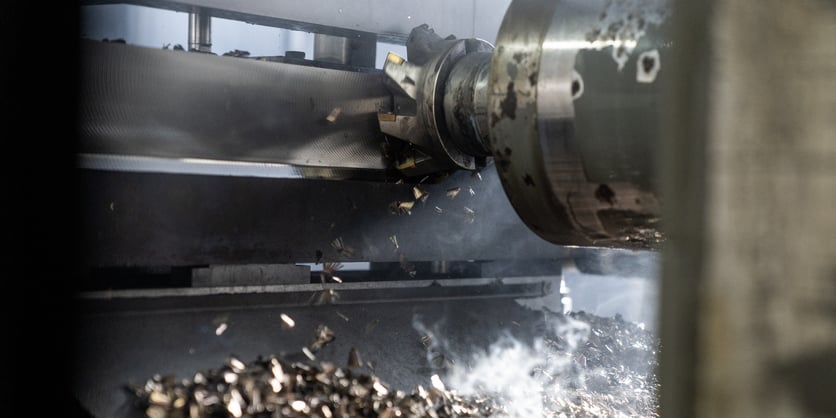Each CNC machine shop must have similar capabilities to other shops, right? Not at all! They do vary in their skill levels and abilities to take on complex parts. That extreme precision demands the accuracy of CNC machine tools, along with experienced operators.
Let’s review 3 quick ways that you can tell that a shop lives and breathes complex parts:
- Investment in CNC machine tools — Some complex parts’ extremely tight tolerances may require investing in new CNC machinery. High-end machine shops equip themselves to take on demanding tolerance levels that a complex part may require.
- Experienced staff — Developing the right process and tool starts upfront with the sales, engineering, quality, and production teams. Look for a shop that’s able to handle complex parts from start to finish (design to assembly) all in-house.
- Close relationships with foundries — Work with pros that fully understand metal castings and have design/build experience. Shops can control quality, reduce timelines, and make changes smoothly, especially prior to production, when changes aren’t cost-prohibitive.
Key Critical Characteristics (KCC) Nail Quality Expectations
The best CNC machine shops can review a print and instantly point out a handful of features that will make or break a part as far as cost-efficiency goes. For these key critical characteristics (KCC), the pressure is on to produce the highest quality work possible … repeatedly, reliably, and robustly for a healthy bottom line.
From a two-dollar part to one that exceeds five figures, proper machining that nails KCCs can eliminate customer complaints, warranty claims, and other points of dissatisfaction.
Types of CNC Tools and Techniques
Below, we’ll dive into many factors that affect how a shop selects a tool. First, let’s explore how demanding a complex parts can be and review processes that put CNC machine tools into use.
One complex part may require 100 cutting tools or more in order to process it properly. If that CNC machine center can’t handle the tools needed, that part will be moved to a more capable machine center. The cost of a high-priced, multitask tool is justified by a high quantity of parts that will eventually be made by that tool.
CNC machining techniques:
- Milling — a rotating cutting tool contacts a stationary workpiece
- Turning — a workpiece is rotated to contact a cutting tool
- Drilling — a rotating cutting tool contacts a workpiece, making a hole
- Boring — material is removed within a workpiece’s inner cavity
- Broaching — material is removed with numerous shallow cuts
- Sawing — a narrow slit is cut in a workpiece with a saw blade
The Factors That Affect Machine Shop Tool Selection
PART SIZE — Weight doesn’t determine what CNC machine tool technology is needed; it’s the part’s dimensions. An engine block, a part with high tolerance levels that relies heavily on proper machinability, is large enough to demand specific equipment for machining.
On a related note, size alone doesn’t determine a part’s complexity; some smaller parts are extremely challenging, and some large parts are relatively simple.
PART PROCESSING — Consider the number of operations (and order) needed to machine a part: a lathe for turning; a mill for cutting a surface; or even how the part needs to be held to machine certain angles. To increase efficiency, a multitasking machine may be used if it’s cost-effective for the shop to purchase.
PART TOLERANCE — A shiny, new (and expensive) machine can be purchased to handle nearly any tolerance needed. Yet, the processing of the part (when to perform which features, how to hold the part, which cut to make first, etc.) is key to achieving the accuracy that’s demanded with many complex parts.
MATERIAL — A material’s rigidity determines the spindle speed of the tool and the machine’s needed horsepower. Aluminum can be run faster than iron, for instance.
TOOLING UP — Getting a CNC machine prepared for processing a part is critical for a machine shop to be competitive. Performing multiple functions with a single combo tool increases quality and accuracy upon repeat uses. And, only having to use one machine for various functions reduces risks and the possibility of a bur or misalignment.
CYCLE TIME — An accurate anticipated quoted cycle time generates pinpoint rates that are vital for a machine shop to stay competitive. An experienced design team that knows the capabilities of a machine helps ensure the project is priced correctly. There’s always a goal to reduce cycle times so work can be put into the machine to increase robustness and repeatability, and offload operator processing.
QUANTITY — Depending on the overall lifetime of the project, which could be years, the quantity (perhaps thousands of parts) may justify purchasing a piece of equipment specific to that part. The contract may extend for years with an annual usage, which could make it optimal for robotics instead of heavy labor requirements.
LABOR NEEDS — Other than safety, quality and efficiency are the most important factors in getting a project through a CNC machine shop. One technician working at one machine is drastically different than moving that part through five different stations and multiple people. And, as challenging as it may be, striving to achieve lean practices is always a goal.
Although “complex” is tricky to define in the machine shop world, it’s easy to see the value of using quality CNC machine tools operated by the right CNC technicians. The tasks many machine shops shy away from are welcomed by some machine shops that simply love the tough stuff, and they prepare themselves for those complex challenges.
Ready to lern more about CNC tooling? Within our guide, CNC Tooling Improvements and Partnerships: A Guide to Solving Specific Tooling Issues, you’ll find four real-life cutting tool improvement examples from Stecker Machine. Click the link below for your copy.







